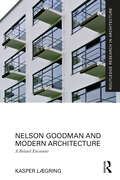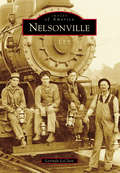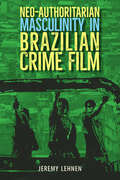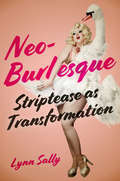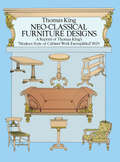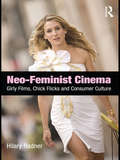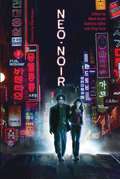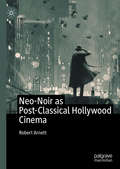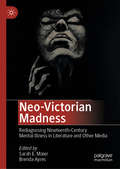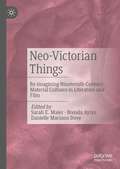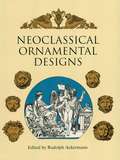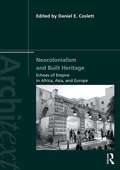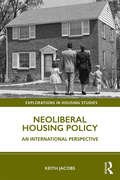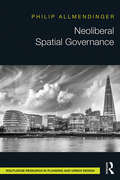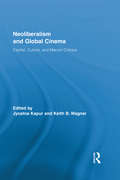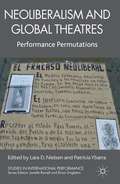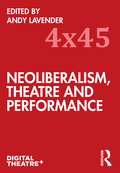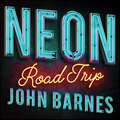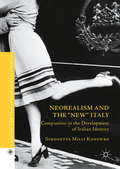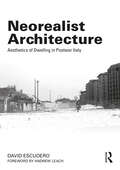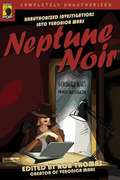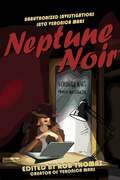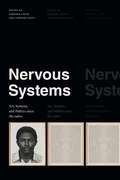- Table View
- List View
Nelson Goodman and Modern Architecture: A Belated Encounter (Routledge Research in Architecture)
by Kasper LægringThis book orchestrates a convergence of two discourses from the 1960s—Nelson Goodman’s aesthetic theory on one side and critiques of modern architecture articulated by figures like Peter Blake, Charles Jencks, and Robert Venturi/Denise Scott Brown on the other. Grounded in Goodman’s aesthetic theory, the book explores his conceptual framework within the context of modern architecture.At the heart of the investigation lies Goodman’s concept of exemplification. While his notion of denotation pertains to representational elements, often ornaments, in architecture, exemplification accentuates specific formal properties at the expense of others, including color, spatial orientation, transparency, seriality, and the like. Supplemented by findings from phenomenology, the book traces these effects in buildings, notably those by Ludwig Mies van der Rohe, Walter Gropius, Le Corbusier, and Frank Lloyd Wright—all key figures in the critiques of modern architecture.Employing Goodman’s framework, the book aims to address accusations of emptiness and alienation directed at modern architecture in the postwar era. It illustrates that modern architecture symbolizes aesthetically in a fundamentally different way than architecture from earlier periods.This book will be of interest to architects, artists, researchers, and students in architecture, architectural history, theory, cultural theory, philosophy, and aesthetics.
Nelsonville
by Lorinda LeclainNamed for Daniel Nelson, who arrived with his family in 1814, Nelsonville grew to become a boomtown by the mid-1800s. Coal mines and brick factories were its major employers, and the town attracted emigrant workers from England. Two major routes, the Hocking Canal and Hocking Valley Railroad, not only provided transportation for the area but also a means to export coal. The canal suffered attacks by Gen. John Hunt Morgan and his Confederate cavalry during the Civil War and was ultimately destroyed by spring flooding, but the railroad has remained a premiere tourist attraction. The Public Square, around which the earliest establishments such as the Dew House were erected, continues to thrive as an arts district. Images of America: Nelsonville uses archival photographs and postcards to celebrate the most influential people and beloved places of the "Little City of Black Diamonds" and to recap the challenges and triumphs that helped earn Nelsonville its distinctive reputation.
Neo-Authoritarian Masculinity in Brazilian Crime Film (Reframing Media, Technology, and Culture in Latin/o America)
by Jeremy LehnenAnalyzing how masculinity is portrayed in Brazilian crime film, connecting movie messages to twenty-first-century issues An incisive analysis of contemporary crime film in Brazil, this book focuses on how movies in this genre represent masculinity and how their messages connect to twenty-first-century sociopolitical issues. Jeremy Lehnen argues that these films promote an agenda in support of the nation’s recent swing toward authoritarianism that culminated in the 2018 election of far-right president Jair Bolsonaro. Lehnen examines the integral role of masculinity in several archetypal crime films, most of which foreground urban violence, including Cidade de Deus, Quase Dois Irmãos, Tropa de Elite, O Homem do Ano, and O Doutrinador. Within these films, Lehnen finds representations that criminalize the poor, marginalized male; emasculate the civilian middle-class male intellectual, casting him as unable to respond to crime; and portray state security as the only power able to stem increasing crime rates. Drawing on insights from masculinity studies, Lehnen contends that Brazilian crime films are ideologically charged mediums that assert and normalize the presence of the neo-authoritarian male within society. This book demonstrates how gendered scripts can become widely accepted by audiences and contribute to very real power structures beyond the sphere of cinema. A volume in the series Reframing Media, Technology, and Culture in Latin/o America, edited by Héctor Fernández L’Hoeste and Juan Carlos RodríguezPublication of this work made possible by a Sustaining the Humanities through the American Rescue Plan grant from the National Endowment for the Humanities.
Neo-Burlesque: Striptease as Transformation
by Lynn SallyThe neo-burlesque movement seeks to restore a sense of glamour, theatricality, and humor to striptease. Neo-burlesque performers strut their stuff in front of audiences that appreciate their playful brand of pro-sex, often gender-bending, feminism. Performance studies scholar and acclaimed burlesque artist Lynn Sally offers an inside look at the history, culture, and philosophy of New York’s neo-burlesque scene. Revealing how twenty-first century neo-burlesque is in constant dialogue with the classic burlesque of the nineteenth and twentieth centuries, she considers how today’s performers use camp to comment on preconceived notions of femininity. She also explores how the striptease performer directs the audience’s gaze, putting on layers of meaning while taking off layers of clothing. Through detailed profiles of iconic neo-burlesque performers such as Dita Von Teese, Dirty Martini, Julie Atlas Muz, and World Famous *BOB*, this book makes the case for understanding neo-burlesque as a new sexual revolution. Yet it also examines the broader community of “Pro-Am” performers who use neo-burlesque as a liberating vehicle for self-expression. Raising important questions about what feminism looks like, Neo-Burlesque celebrates a revolutionary performing art and participatory culture whose acts have political reverberations, both onstage and off.
Neo-Classical Furniture Designs: A Reprint Of Thomas King's Modern Style Of Cabinet Work Exemplified, 1829
by Thomas KingInfluential guide displays over 300 Grecian designs: fire screens, sofas, couches, chairs, footstools, commodes, sideboards, washstands, bedsteads,and many other items.
Neo-Feminist Cinema: Girly Films, Chick Flicks, and Consumer Culture
by Hilary RadnerWhat lies behind current feminist discontent with contemporary cinema? Through a combination of cultural and industry analysis, Hilary Radner’s Neo-Feminist Cinema: Girly Films, Chick Flicks and Consumer Culture shows how the needs of conglomerate Hollywood have encouraged an emphasis on consumer culture within films made for women. By exploring a number of representative "girly films," including Pretty Woman, Legally Blonde, Maid in Manhattan, The Devil Wears Prada, and Sex and the City: The Movie, Radner proposes that rather than being "post-feminist," as is usually assumed, such films are better described as "neo-feminist." Examining their narrative format, as it revolves around the story of an ambitious unmarried woman who defines herself through consumer culture as much as through work or romance, Radner argues that these films exemplify neo-liberalist values rather than those of feminism. As such, Neo-Feminist Cinema offers a new explanation as to why feminist-oriented scholars and audiences who are seeking more than "labels and love" from their film experience have viewed recent "girly films" as a betrayal of second-wave feminism, and why, on the other hand, such films have proven to be so successful at the box office.
Neo-Noir (Wallflower Press #PPCS)
by Greg Tuck Kathrina Glitre Mark BouldNeo-noir knows its past. It knows the rules of the game – and how to break them. From Point Blank (1998) to Oldboy (2003), from Get Carter (2000) to 36 Quai des Orfèvres (2004), from Catherine Tramell to Max Payne, neo-noir is a transnational global phenomenon. This wide-ranging collection maps out the terrain, combining genre, stylistic and textual analysis with Marxist, feminist, psychoanalytic and industrial approaches. Essays discuss works from the US, UK, France, Japan, South Korea, Hong Kong and New Zealand; key figures, such as David Lynch, the Coen Brothers, Quentin Tarantino and Sharon Stone; major conventions, such as the femme fatale, paranoia, anxiety, the city and the threat to the self; and the use of sound and colour.
Neo-Noir as Post-Classical Hollywood Cinema
by Robert ArnettNeo-Noir as Post-Classical Hollywood Cinema suggests the terms “noir” and “neo-noir” have been rendered almost meaningless by overuse. The book seeks to re-establish a purpose for neo-noir films and re-consider the organization of 60 years of neo-noir films. Using the notion of post-classical, the book establishes how neo-noir breaks into many movements, some based on time and others based on thematic similarities. The combined movements then form a mosaic of neo-noir. The time-based movements examine Transitional Noir (1960s-early 1970s), Hollywood Renaissance Noir in the 1970s, Eighties Noir, Nineties Noir, and Digital Noir of the 2000s. The thematic movements explore Nostalgia Noir, Hybrid Noir, and Remake and Homage Noir. Academics as well as film buffs will find this book appealing as it deconstructs popular films and places them within new contexts.
Neo-Victorian Madness: Rediagnosing Nineteenth-Century Mental Illness in Literature and Other Media
by Sarah E. Maier Brenda AyresNeo-Victorian Madness: Rediagnosing Nineteenth-Century Mental Illness in Literature and Other Media investigates contemporary fiction, cinema and television shows set in the Victorian period that depict mad murderers, lunatic doctors, social dis/ease and madhouses as if many Victorians were “mad.” Such portraits demand a “rediagnosing” of mental illness that was often reduced to only female hysteria or a general malaise in nineteenth-century renditions. This collection of essays explores questions of neo-Victorian representations of moral insanity, mental illness, disturbed psyches or non-normative imaginings as well as considers the important issues of legal righteousness, social responsibility or methods of restraint and corrupt incarcerations. The chapters investigate the self-conscious re-visions, legacies and lessons of nineteenth-century discourses of madness and/or those persons presumed mad rediagnosed by present-day (neo-Victorian) representations informed by post-nineteenth-century psychological insights.
Neo-Victorian Things: Re-imagining Nineteenth-Century Material Cultures in Literature and Film
by Sarah E. Maier Brenda Ayres Danielle Mariann DoveNeo-Victorian Things: Re-Imagining Nineteenth-Century Material Cultures in Literature and Film is the first volume to focus solely on the replication, reconstruction, and re-presentation of Victorian things. It investigates the role of materiality in contemporary returns to the past as a means of assessing the function of things in remembering, revisioning, and/or reimagining the nineteenth century. Examining iterations of material culture in literature, film and popular television series, this volume offers a reconsideration of nineteenth-century things and the neo-Victorian cultural forms that they have inspired, animated, and even haunted. By turning to new and relatively underexplored strands of neo-Victorian materiality—including opium paraphernalia, slave ships, clothing, and biographical objects—and interrogating the critical role such objects play in reconstructing the past, this volume offers ways of thinking about how mis/apprehensions of material culture in the nineteenth century continue to shape our present understanding of things.
Neoclassical Ornamental Designs
by Rudolph AckermannGraphic artists, illustrators, desktop publishers - anyone in search of elegant classical ornament - will find a wealth of usable material in this handy resource, reproduced from rare 19th-century portfolios. Readers can choose from borders, corners, vignettes, cartouches, busts, ornamental designs, and many other configurations depicting gods and goddesses, mythical animals, floral and foliate motifs, urns, chariots, helmets, angels and cherubs, columns, figures from classical mythology, and more - all in fine-line renderings that convey a sense of timeless elegance and classical ambience. Ideal for adding pictorial interest to book and magazine illustrations, advertisements, brochures, and many other projects, these designs comprise an easy-to-use, copyright-free reference that belongs at the fingertips of anyone wishing to create eye-catching graphics with a classical touch.
Neocolonialism and Built Heritage: Echoes of Empire in Africa, Asia, and Europe (Architext)
Architectural relics of nineteenth and twentieth-century colonialism dot cityscapes throughout our globalizing world, just as built traces of colonialism remain embedded within the urban fabric of many European capitals. Neocolonialism and Built Heritage addresses the sustained presence and influence of historic built environments and processes inherited from colonialism within the contemporary lives of cities in Africa, Asia, and Europe. Novel in their focused consideration of ways in which these built environments reinforce neocolonialist connections among former colonies and colonizers, states and international organizations, the volume’s case studies engage highly relevant issues such as historic preservation, heritage management, tourism, toponymy, and cultural imperialism. Interrogating the life of the past in the present, authors thus challenge readers to consider the roles played by a diversity of historic built environments in the ongoing asymmetrical balance of power and unequal distribution capital around the globe. They present buildings’ maintenance, management, reuse, and (re)interpretation, and in so doing they raise important questions, the ramifications of which transcend the specifics of the individual sites and architectural histories they present.
Neoliberal Housing Policy: An International Perspective (Explorations in Housing Studies)
by Keith JacobsNeoliberal Housing Policy considers some of the most significant housing issues facing the West today, including the increasing commodification of housing; the political economy surrounding homeownership; the role of public housing; the problem of homelessness; the ways that housing accentuates social and economic inequality; and how suburban housing has transformed city life. The empirical focus of the book draws mainly from the US, UK and Australia, with examples to illustrate some of the most important features and trajectories of late capitalism, including the commodification of welfare provision and financialisation, while the examples from other nations serve to highlight the influence of housing policy on more regional- and place-specific processes. The book shows that developments in housing provision are being shaped by global financial markets and the circuits of capital that transcend the borders of nation states. Whilst considerable differences within nation states exist, many government interventions to improve housing often fall short. Adopting a structuralist approach, the book provides a critical account of the way housing policy accentuates social and economic inequalities and identifies some of the significant convergences in policy across nations states, ultimately offering an explanation as to why so many ‘inequalities’ endure. It will be useful for anyone in professional housing management/social housing programmes as well as planning, sociology (social policy), human geography, urban studies and housing studies programmes.
Neoliberal Spatial Governance
by Phil AllmendingerNeoliberal Spatial Governance explores the changing nature of English town and city planning as it has slowly but clearly transformed. Once a system for regulating and balancing change in the built and natural environments in the public interest, planning now finds itself facilitating development and economic growth for narrow, sectional interests. Whilst there is a lip service towards traditional values, the progressive aims and inclusivity that provided planning’s legitimacy and broad support have now largely disappeared. The result is a growing backlash of distrust and discontent as planning has evolved into neoliberal spatial governance. The tragedy of this change is that at a time when planning has a critical role in tackling major issues such as housing affordability and climate change, it finds itself poorly resourced with low professional morale, lacking legitimacy and support from local communities, accused of bureaucracy and ‘red tape’ from businesses and ministers and subject to regular, disruptive reforms. Yet all is not lost. There is still demand and support for more comprehensive and progressive planning, one that is not purely driven by the needs of developers and investors. Resistance against the idea that planning exists to help roll out development, is growing. Neoliberal Spatial Governance explores the background and implications of the changes in planning under the governments of the past four decades and the ways we might think about halting and reversing this shift.
Neoliberalism and Global Cinema: Capital, Culture, and Marxist Critique (Routledge Advances in Film Studies)
by Jyotsna Kapur Keith B. WagnerIn cinema studies today, rarely do we find a direct investigation into the culture of capitalism and how it has been refracted and fabricated in global cinema production under neoliberalism. However, the current economic crisis and the subsequent Wall Street bailout in 2008 have brought about a worldwide skepticism regarding the last four decades of economic restructuring and the culture that has accompanied it. In this edited volume, an international ensemble of scholars looks at neoliberalism, both as culture and political economy, in the various cinemas of the world. In essays encompassing the cinemas of Asia, Africa, Latin America, Europe, and the United States the authors outline how the culture and subjectivities engendered by neoliberalism have been variously performed, contested, and reinforced in these cinemas. The premise of this book is that the cultural and economic logic of neoliberalism, i.e., the radical financialization and market-driven calculations, of all facets of society are symptoms best understood by Marxist theory and its analysis of the central antagonisms and contradictions of capital. Taking a variety of approaches, ranging from political economy, ideological critique, the intersection of aesthetics and politics, social history and critical-cultural theory, this volume offers a fresh, broad-based Marxist analysis of contemporary film/media. Topics include: the global albeit antagonistic nature of neoliberal culture; the search for a new aesthetic and documentary language; the contestation between labor and capital in cultural producion; the political economy of hollywood, and questions of gender, sexuality, and the nation state in relation to neoliberalism.
Neoliberalism and Global Theatres
by Lara D. Nielsen Patricia YbarraHow do theatre and performance transmit and dispute ideologies of neoliberalism? The essays in this collection, now available in paperback for the first time, examine the mechanisms and rhetorics artists, communities, and institutions deploy to produce theatre and performance for global audiences. Neoliberalism and Global Theatres: Performance Permutations explores how the conditions of neoliberalism affect productions of theatre and performance globally, including case studies about New Zealand, Singapore, Vietnam, China, Peru, Mexico, Indonesia, Brazil, India, Nigeria, and the United States. The 18 essays by cutting-edge scholars reveal how performance circulates, transmutes and challenges the disciplinary formations and assumptions organizing contemporary investment in market logics, and, paradoxical notions of freedom. The book brings together diverse perspectives that challenge readers to grapple with the effects of globalized capital on theater, dance, film, visual art, televisual performance and music. Neoliberalism and Global Theatres: Performance Permutations provides an excellent introduction to neoliberalism for arts and humanities students studying performance in a global context.
Neoliberalism, Theatre and Performance (4x45)
by Andy LavenderNeoliberalism, Theatre and Performance tackles one of the most slippery but significant topics in culture and politics. Neoliberalism is defined by the contributors as a political-economic system, and the ideas and assumptions (individualism, market forces and globalisation) that it promotes are consequently examined. Readers will gain an insight into how neoliberalism shapes contemporary theatre, dance and performance, and how festival programmers, directors and other artists have responded. Jen Harvie gives a broad overview of neoliberalism, before examining its implications for theatre and performance and specific works that confront its grip, including Churchill’s Serious Money and Prebble’s Enron. Liesbeth Groot Nibbelink conducts a fascinating discussion with Rainer Hofmann, artistic director of the SPRING Festival in Utrecht, on ways in which performance festivals can respond to neoliberal culture. Cristina Rosa explores contemporary dance in neoliberal Brazil as a site for both commodification and challenge. Sarah Woods and Andrew Simms discuss and present excerpts from their activist satire Neoliberalism: The Break-up Tour. Slim and elegant, forceful and wide-ranging, Neoliberalism, Theatre and Performance is an accessible resource for students, practitioners and scholars interested in how neoliberalism both suffuses and is resisted by today’s contemporary performance scene.
Neon Road Trip
by John BarnesNeon Road Trip chronicles the history of the commercial neon sign with a curated collection of photographs capturing the most colorful and iconic neon still surviving today. The vivid photographs are arranged according to the signs' imagery, with sections such as Spirit of the West, On the Road, Now That’s Entertainment, and Ladies, Diving Girls & Mermaids. Sixteen of the most iconic landmark signs include brief histories on how that unique sign came to be. A resource section includes a photography index by location and a Neon Museums Visitor’s Guide.
Neorealism and the "New" Italy
by Simonetta Milli KonewkoNeorealism and the "New" Italy centers on neorealist Italian artists' use of compassion as a vehicle to express their characters' interactions. Simonetta Milli Konewko proposes that compassion as an emotion may be activated to unify certain individuals and communities and investigates the mechanisms that allowed compassion to operate during the postwar period. Aiming to produce a deeper understanding of the ways in which Italy is re-encoded and reconstructed, this book explores the formation of Italian identity and redefines neorealism as a topic of investigation.
Neorealist Architecture: Aesthetics of Dwelling in Postwar Italy
by David EscuderoAfter World War II, a wave of Italian films emerged that depicted the life and hardships of characters left helpless after the conflict, bringing to the screen the struggles of a time of existential angst and uncertainty. This form of filmmaking was associated with a broader artistic phenomenon known as ‘neorealism’ and is now considered a pivotal point in the history of Italian cinema. But neorealism was not limited to film any more than it was to literature. It spread to other areas of artistic production, including architecture. What was, then, neorealist architecture? This book explores the links between architecture, filmmaking and the built environment in dopoguerra Italy (194X–195X) seeking to ascertain whether, and how, neorealism manifested itself in architecture. Terms such as ‘neorealist architecture’ or ‘architectural neorealism’ were hinted at in these years and recalled by historians of architecture in the following decades. Therefore, the concept was adopted ad hoc and popularized post hoc, in the absence of any declarations prior to 1955 that proclaimed what neorealism in architecture was or wanted to be. However, while the concept has been internalized by Italian architectural history, transfers between neorealism—as an aesthetic and ethic—and architecture—as one potential medium of its embodiment or expression—are still not fully understood. Therefore, its main goal is to provide an in-depth discussion of the concept ‘neorealist architecture’, the working assumption being that the connection between both terms is not meaningless. The book is beautifully illustrated with over 100 black and white archival images and is the first book to be published on neorealism in architecture. It will appeal to scholars, professionals, and students interested in history and theory of architecture, Italian studies, art history, and cultural studies.
Neptune Noir: Unauthorized Investigations into Veronica Mars
by Rob Thomas"Neptune Noir" is a collection of essays on the hit TV drama "Veronica Mars," and is not authorized by CW, the creators or producers of "Veronica Mars," or any entity associated with the show.
Neptune Noir: Unauthorized Investigations into Veronica Mars
by Rob ThomasNeptune Noir is a collection of essays on the hit drama Veronica Mars, and is not authorized by CW, the creators or producers of Veronica Mars, or any entity associated with the show. More than just a high school drama, Veronica Mars is a smart and savvy teen detective show that offers complex mysteries and rapier wit, engaging social commentary, and noir sensibilities—with the occasional murder thrown in for good measure. This collection, edited by the creator and executive producer of the show, offers supreme insight into the class struggles and love stories of the series. Essays by top writers intelligently address a multitude of questions, such as Is Veronica a modern-day vigilante? Why is a show that features rape, potential incest, and a teen girl outsmarting local authorities so popular with America's conservative population? and Why is Veronica and Logan's relationship the most important story-driving factor in the show?
Nervous Systems: Art, Systems, and Politics since the 1960s
by Johanna Gosse and Timothy StottThe contributors to Nervous Systems reassess contemporary artists' and critics' engagement with social, political, biological, and other systems as a set of complex and relational parts: an approach commonly known as systems thinking. Demonstrating the continuing relevance of systems aesthetics within contemporary art, the contributors highlight the ways that artists adopt systems thinking to address political, social, and ecological anxieties. They cover a wide range of artists and topics, from the performances of the Argentinian collective the Rosario Group and the grid drawings of Charles Gaines to the video art of Singaporean artist Charles Lim and the mapping of global logistics infrastructures by contemporary artists like Hito Steyerl and Christoph Büchel. Together, the essays offer an expanded understanding of systems aesthetics in ways that affirm its importance beyond technological applications detached from cultural contexts.Contributors. Cristina Albu, Amanda Boetzkes, Brianne Cohen, Kris Cohen, Jaimey Hamilton Faris, Christine Filippone, Johanna Gosse, Francis Halsall, Judith Rodenbeck, Dawna Schuld, Luke Skrebowski, Timothy Stott, John Tyson
The NES Encyclopedia: Every Game Released for the Nintendo Entertainment System
by Chris ScullionA comprehensive, colorful guide to every game ever released on the classic Nintendo Entertainment System. One of the most iconic video game systems, the NES is credited with saving the American video games industry in the early 1980s. The NES Encyclopedia is the first ever complete reference guide to every game released on the Nintendo Entertainment System, Nintendo&’s first industry-defining video game system. As well as covering all 714 officially licensed NES games, the book also includes more than 160 unlicensed games released during its lifespan, giving for the first time a definitive history of this important console's full library. Written by a retro gaming expert with 30 years of gaming experience and a penchant for bad jokes, TheNES Encyclopedia promises to be both informative and entertaining. The NES continues to enjoy a strong cult following among Nintendo fans and gamers in general with wide varieties of officially licensed merchandise proving ever popular. Nintendo&’s most recent console, the Switch, is the fastest selling video game console of all time in the United States and Japan. Nintendo launched a variety of classic NES games for download on the system, meaning a new audience of gamers is due to discover the NES for the first time if they have not already. Praise for The NES Encyclopedia &“As a catalog of all 876 NES games, this work is unique in its breadth of coverage and will be of great interest to old-school video gamers and collectors.&” —Booklist &“A definitive resource that is more than worthy of the title &‘Encyclopedia.&’ &” —Nintendo World Report
A Nest For Celeste: A Story About Art, Inspiration, and the Meaning of Home
by Henry ColeCeleste is a mouse who is looking for a home. Is it nestled in the toe of a warm boot? In the shirt pocket of Celeste's new friend Joseph, who is Audubon's apprentice? Or is home the place deep inside Celeste's heart, where friendships live?
